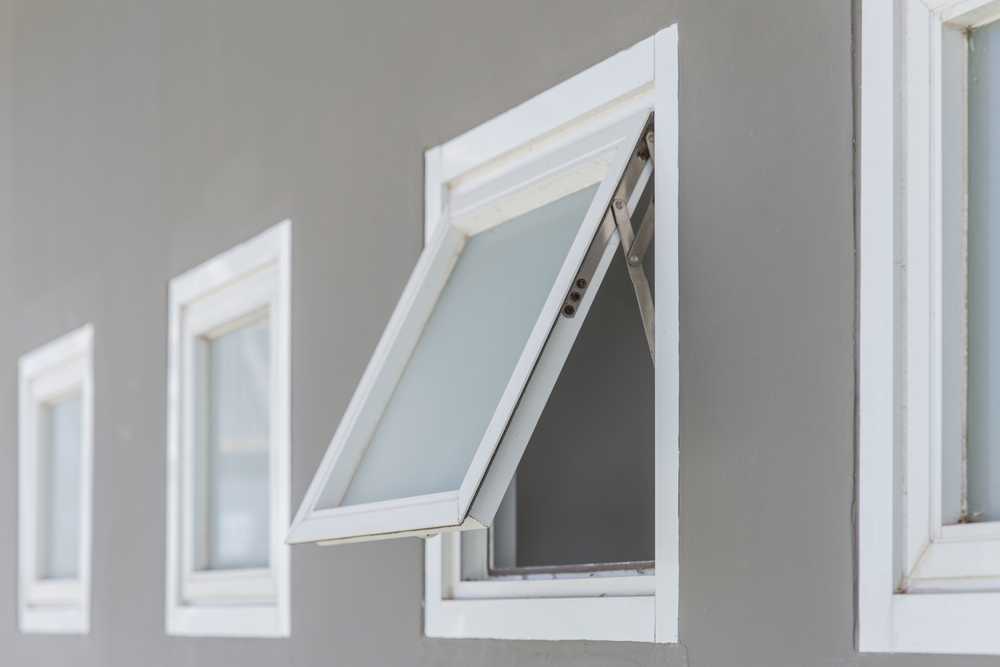Before homeowners can understand the pros and cons of awning windows, they should first learn what they are. These windows work like casement windows, and open out. Their hinges are placed at the top, which makes them much different than average windows. When people open an awning window, it will form a clear awning over the window space. Take a look at the pros and cons below to decide if an awning window is right for your home or project!
Pro #1: Better Ventilation
Selecting an awning window can provide your home with better ventilation and lighting due to their unique size and placement. Take a rainstorm, for example, because of the way the window opens, people can open their awning windows when it rains. While this will let the cool air in, it keeps the rain out!
Pro #2: More Modern Look
Awning windows have become a popular choice in modern homes because of their minimalist and unique style. At the same time, they are also highly energy-efficient. Windows visible from the home’s exterior help define the style of the home, and awning windows absolutely do with their unique layout and placement.
Pro #3: Low Cost
Normally, awning windows will cost less than what an individual would pay for other types of windows. You can expect to pay anywhere from $320 up to $550 per window.
Pro #4: Better Materials for Windows
Awning windows are available in a wide range of materials. Wood or steel-frame windows are very popular but usually cost the most. Wood or steel framed windows can also be very high-end with plenty of customization options. In addition, fiberglass and aluminum are also very popular materials for awning windows. These do not offer as much customization but they still provide plenty of options for the homeowner. Vinyl is also a good choice if you’re looking for a less expensive option that is also well insulated.
Pro #5: Energy-efficient Choice
When it comes to a home’s energy use, windows can have a very big impact. For this reason, people want to choose windows that will help them tightly close off their home to outside elements. An awning window leaks less air than more traditional windows, while also providing the home with great insulation. The U-factor is a measurement used to express the insulation value of windows, The U-factor for awning windows will be anywhere between 0.17 to 0.18. This number describes the window’s ability to keep heat from escaping the home or during the summer months, keeping the cold air in. With that in mind, people want a lower U-factor rating because this means they have a higher quality window.
Pro #6: Security
Compared to more traditional windows, awning windows are much less likely to compromise a home’s security. They will provide natural lighting as well as good ventilation throughout the home without adding risk of someone breaking and entering due to their size and placement. Some ideal places for awning windows include the bathroom or bedroom. Due to awning windows’ ease of use and compact design, they are also great to add over a sink or a counter.
Pro #7: Versatile Construction
Likely one of the best things about this type of window is their versatility. Awning windows come in a wide variety of shapes and designs which certainly help from a design and customization standpoint. The design can be highly flexible, giving the designers the ability to provide unique decorations that wouldn’t normally fit with an average size or formatted window. People might choose to feature their awning windows in a pattern or use them to provide a unique light inside. Whatever you choose, these windows can fit into a variety of areas and rooms. In addition to the versatile placement and design, awning windows also offer substantial variety in materials.
Some of the types of materials that can be used for awning windows include:
- Impact resistant
- Vinyl clad
- Fiberglass
- Fiberglass-clad
- Architectural grade
- Wood
Con #1: Easy to Run Into
If you have a high-traffic area outside, we do not suggest installing awning windows on the first floor in that area. High traffic outside areas and outward-opening windows can be a potentially dangerous combination as people could run into them. This could cause damage to the window or worse, an injury to someone outside. With that in mind, the areas to avoid include patios, porches, decks, sidewalks and terraces.
Con #2: Not Helpful in Emergency Exit Situations
Unfortunately, these windows can be difficult to use for fire escape plans. If there is a fire in the home, they do not offer a quick or safe exit. Another one of the reasons for this also comes from the fact that these windows tend to be higher up on the wall. Most importantly, people should be aware of the local building regulations and codes to ensure safety compliance. If an individual were looking at installing these windows, they should be sure to check all potential fire escape routes and plan to incorporate other types of windows for this reason.
Con #3: Harder to Clean
These windows can be tricky to clean because of how they open. The open slant can provide difficult areas to reach and often times require a little more attention when dusting and cleaning.
Pros and Cons of Awning Windows
People could say that awning windows have a lot of similarities to casement windows. However, instead of opening to the side, these windows will open from the bottom. The hinges will also be located near the top instead of at the side. As you have read above, awning windows certainly offer plenty of advantages but homeowners must also factor in the few disadvantages before making their decision. If you’re interested in Denver window replacement, reach out to us, we’re more than happy to help!


